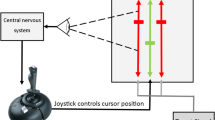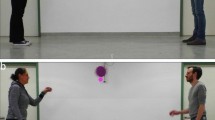Abstract
The mechanisms underlying tracking and capture of moving objects in non-human animals are poorly understood. This set of experiments sought to further explore aspects of anticipatory tracking in pigeons and to conduct comparisons with human participants. In Experiment 1a, pigeons were presented with two types of varying velocities (fast-slow-fast or slow-fast-slow) in separate phases. They were readily able to track and anticipate both of these motion types. To examine the effects of predictability on anticipatory tracking, Experiment 1b presented the pigeons with the same two varying velocities randomly intermixed within a session. This resulted in reduced capture success, later capture, and errors that no longer anticipated ahead of the motion, suggesting that the anticipatory mechanism had been disrupted. This implies that the mechanisms involved in pigeon tracking are different from the predictive extrapolation mechanism proposed in humans. Experiment 2 tested this by presenting adult humans with a tracking task that was similar to tasks previously received by the pigeons. The capture behavior of humans was similar to the pigeons, but the errors revealed different processes underlying their tracking behavior.





Similar content being viewed by others
References
Byers JA (2002) The ungulate mind. In: Bekoff M, Allen C, Burghardt GM (eds) The cognitive animal: empirical and theoretical perspectives on animal cognition. The MIT Press, Cambridge, pp 35–39
Frost BJ, DiFranco DE (1976) Motion characteristics of single units in the pigeon optic tectum. Vis Res 16:1229–1234
Frost BJ, Nakayama K (1983) Single visual neurons code opposing motion independent of direction. Science (Washington DC, 1883) 220:744–745
Gredebaak G, von Hofsten C, Boudreau JP (2002) Infants’ visual tracking of continuous circular motion under conditions of occlusion and non-occlusion. Inf Behav Dev 144:1–21
Hedenström A, Rosén M (2001) Predator versus prey: on aerial hunting and escape strategies in birds. Behav Ecol 12:150–156
Jenkins HM, Moore BR (1973) The form of the auto-shaped response with food or water reinforcers. J Exp Anal Behav 20:163–181
Kochukhova O, Gredebäck G (2007) Learning about occlusion: Initial assumptions and rapid adjustments. Cognition 105:26–46
Lanchester BS, Mark RF (1975) Pursuit and prediction in tracking of moving food by a teleost fish (Acanthaluteres spilomelanurus). J Exp Biol 63:627–645
McVean A, Davieson R (1989) Ability of the pigeon (Columba livia) to intercept moving targets. J Comp Psychol 103:95–99
Miyata H, Fujita K (2008) Pigeons (Columba livia) plan future moves on computerized maze tasks. Animal Cognition 11:505–516
Miyata H, Ushitani T, Adachi I, Fujita K (2006) Performance of pigeons (Columba livia) on maze problems presented on the LCD screen: in search for preplanning abilities in an avian species. J Comp Psychol 120:1038–1040
Neiworth JJ, Rilling ME (1987) A method for studying imagery in animals. J Exp Psychol Anim Behav Process 13:203–214
Nye PW (1973) On the functional differences between frontal and lateral visual fields of the pigeon. Vis Res 13:559–574
Pisacreta R (1982) Stimulus control of the pigeons ability to peck a moving target. J Exp Anal Behav 37:301–309
Rilling ME (1992) An ecological approach to stimulus control and tracking. In: Honig WK, Fetterman JG (eds) Cognitive aspects of stimulus control. Lawrence Erlbaum Associates, Hillsdale, pp 347–366
Rilling ME, LaClaire TL (1989) Visually guided catching and tracking skills in pigeons: a preliminary analysis. J Exp Anal Behav 52:377–385
Rilling ME, Neiworth JJ (1987) Theoretical and methodological considerations for the study of imagery in animals. Learn Motiv 18:57–79
Rilling ME, LaClaire L, Warner M (1993) A comparative, hierarchical theory for object recognition and action. In: Zentall TR (ed) Animal cognition: a tribute to Donald A Riley. Lawrence Erlbaum Associates, Hillsdale, pp 313–333
Ristau CA (1991a) Aspects of the cognitive ethology of an injury-feigning bird, the piping plover. In: Ristau CA (ed) Cognitive ethology: the minds of other animals. Lawrence Erlbaum Associates, Hillsdale, pp 91–126
Ristau CA (1991b) Before mind reading: Attention purposes and deception in birds? In: Whiten A (ed) Natural theories of mind: evolution, development and simulation of everyday mindreading. Blackwell, Oxford, pp 209–222
Rosander K, Von Hofsten C (2004) Infants’ emerging ability to represent occluded object motion. Cognition 91:1–22
Von Hofsten C (1987) Catching. In: Heuer H, Sanders AF (eds) Perspectives on perception and action. Lawrence Erlbaum Associates, Hillsdale, pp 33–46
von Hofsten C, Vishton P, Spelke ES, Feng Q, Rosander K (1998) Predictive action in infancy: tracking and reaching for moving objects. Cognition 67:255–285
von Hofsten C, Feng Q, Spelke ES (2000) Object representation and predictive action in infancy. Dev Sci 3:192–205
Wilkinson A (2008) Tracking and capture of a moving object in the pigeon (Columba livia). Ph.D. Dissertation. The University of York, 183 pp
Wilkinson A, Kirkpatrick K (2009) Visually guided capture of a moving stimulus by the pigeon (Columba livia). Animal Cognition 12:127–144
Zeigler HP (1974) Feeding behaviour in the pigeon: a neurobehavioural analysis. In: Goodman IJ, Stein NW (eds) Birds, brain, and behaviour. Academic Press, New York, pp 101–132
Acknowledgments
This research was conducted when both authors were at the University of York. It was supported in part by an Innovation and Research Pump Priming Fund grant from the University of York. Some of the research presented in this article formed a part of a PhD dissertation completed by Anna Wilkinson. She is currently at the University of Vienna. The human experiment formed a portion of an undergraduate project conducted by Angela York. Kimberly Kirkpatrick is currently at Kansas State University. The authors would like to thank Tim Chen for programming the experimental task in MATLAB. We would also like to thank Richard Wood and Stuart Morley for technical support and animal care.
Author information
Authors and Affiliations
Corresponding author
Rights and permissions
About this article
Cite this article
Wilkinson, A., Kirkpatrick, K. Tracking and capture of constant and varying velocity stimuli: a cross-species comparison of pigeons and humans. Anim Cogn 14, 59–71 (2011). https://doi.org/10.1007/s10071-010-0343-8
Received:
Revised:
Accepted:
Published:
Issue Date:
DOI: https://doi.org/10.1007/s10071-010-0343-8




